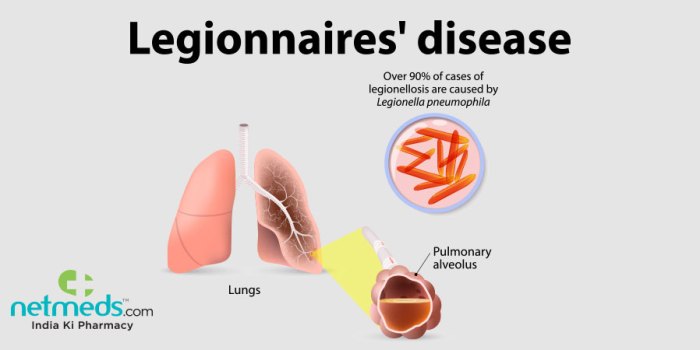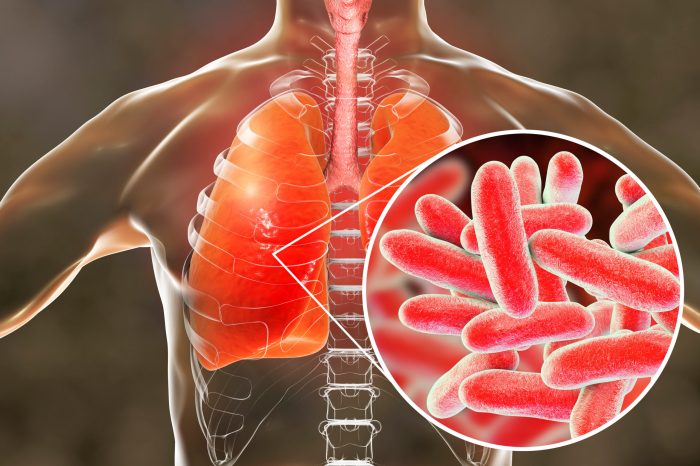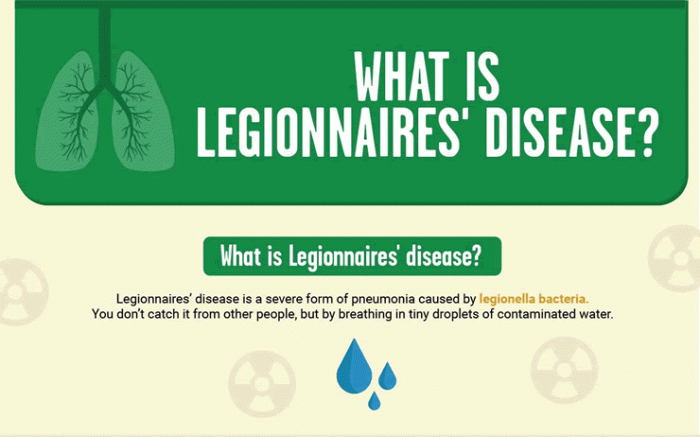Legionnaires disease australia – Legionnaires’ disease is a severe form of pneumonia caused by bacteria that thrive in warm water systems. In Australia, Legionnaires’ disease poses a significant public health concern, with reported cases and outbreaks occurring throughout the country. Understanding the prevalence, risk factors, and prevention strategies is crucial for safeguarding public health and minimizing the impact of this disease.
The prevalence of Legionnaires’ disease in Australia has remained relatively stable in recent years, with an average of around 300 cases reported annually. The disease is more common in older adults, particularly those with weakened immune systems or chronic respiratory conditions.
Cooling towers and evaporative condensers in large buildings, such as hospitals, hotels, and office complexes, are the primary sources of Legionella bacteria, the causative agent of Legionnaires’ disease.
Overview of Legionnaires’ Disease in Australia
Legionnaires’ disease is a severe form of pneumonia caused by bacteria of the Legionellagenus. In Australia, Legionnaires’ disease is a notifiable disease, with an average of 500 cases reported annually. The majority of cases occur in Queensland, New South Wales, and Victoria.
Legionnaires’ disease has a significant impact on public health, with an estimated mortality rate of 10-15%. The economic burden of Legionnaires’ disease is also substantial, with the cost of hospitalization and treatment estimated to be in the millions of dollars each year.
Risk Factors and Transmission
- Age:The risk of Legionnaires’ disease increases with age, with people over 50 years old being at the highest risk.
- Smoking:Smoking damages the lungs, making people more susceptible to Legionnaires’ disease.
- Chronic respiratory conditions:People with chronic respiratory conditions, such as chronic obstructive pulmonary disease (COPD) and asthma, are at an increased risk of Legionnaires’ disease.
- Immunocompromised conditions:People with weakened immune systems, such as those with HIV/AIDS or cancer, are at an increased risk of Legionnaires’ disease.
Legionnaires’ disease is transmitted through the inhalation of aerosolized water droplets containing Legionellabacteria. Common sources of Legionellainclude cooling towers, evaporative condensers, hot water systems, and showers.
Clinical Presentation and Diagnosis

The clinical presentation of Legionnaires’ disease can vary, but typically includes:
- Fever
- Chills
- Cough
- Shortness of breath
- Muscle aches
- Headache
- Nausea and vomiting
Legionnaires’ disease can be diagnosed through a combination of clinical symptoms and laboratory tests. The most common laboratory test used to diagnose Legionnaires’ disease is a urine antigen test, which detects the presence of Legionellabacteria in the urine.
Treatment and Management, Legionnaires disease australia
The treatment for Legionnaires’ disease typically involves a course of antibiotics. The most commonly used antibiotics for Legionnaires’ disease are azithromycin and levofloxacin.
In addition to antibiotics, supportive care may also be necessary, such as oxygen therapy, intravenous fluids, and pain relievers.
Prevention and Control

The key to preventing and controlling Legionnaires’ disease is to control the growth and spread of Legionellabacteria in water systems.
Some of the most important measures for preventing and controlling Legionnaires’ disease include:
- Water system management:This includes maintaining water temperatures above 60°C or below 20°C, and regularly cleaning and disinfecting water systems.
- Disinfection:Chlorine or other disinfectants can be used to kill Legionellabacteria in water systems.
- Monitoring:Water systems should be regularly monitored for the presence of Legionellabacteria.
Research and Surveillance
There is ongoing research into the prevention and treatment of Legionnaires’ disease. Some of the current research initiatives include:
- Developing new antibiotics:New antibiotics are being developed that are more effective against Legionellabacteria.
- Improving water system management:Researchers are developing new methods for managing water systems to prevent the growth and spread of Legionellabacteria.
- Developing new diagnostic tests:New diagnostic tests are being developed that are more sensitive and specific for Legionnaires’ disease.
Surveillance is also an important part of the prevention and control of Legionnaires’ disease. Surveillance helps to identify outbreaks of Legionnaires’ disease and track the spread of the disease.
Closing Summary: Legionnaires Disease Australia

Effective prevention and control measures are essential to minimize the risk of Legionnaires’ disease outbreaks. Regular maintenance and disinfection of water systems, proper management of cooling towers, and implementation of water management plans are crucial. Public health surveillance and outbreak response systems play a vital role in monitoring disease trends, identifying potential outbreaks, and implementing appropriate control measures.
Ongoing research and collaboration between public health agencies and researchers are essential for advancing our understanding of Legionnaires’ disease and developing more effective prevention and treatment strategies.
FAQ Corner
What are the symptoms of Legionnaires’ disease?
Symptoms typically include fever, chills, muscle aches, headache, and shortness of breath.
How is Legionnaires’ disease treated?
Treatment involves antibiotics and supportive care, such as oxygen therapy and intravenous fluids.
How can I prevent Legionnaires’ disease?
Avoid exposure to contaminated water sources, such as cooling towers and evaporative condensers. Maintain proper water hygiene and disinfection practices.